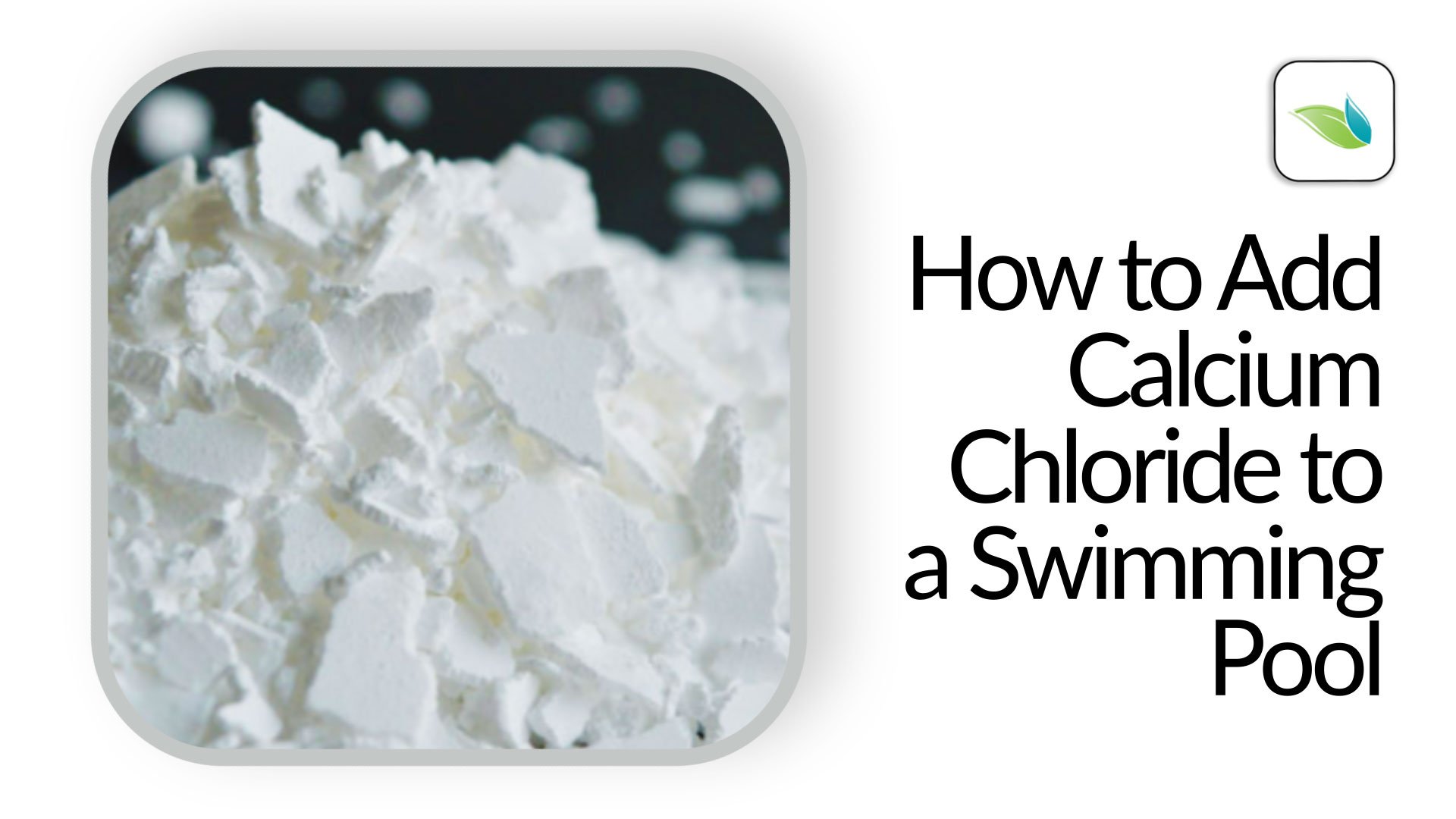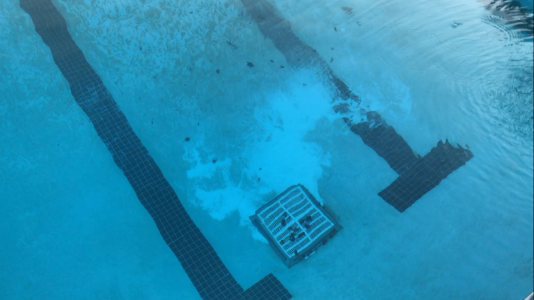How Do I Add Calcium To My Pool

How should we add calcium chloride to a swimming pool? How can we brand sure we're handling it safely, and properly, to avoid unintended consequences? Adding calcium is not as uncomplicated every bit it sounds...you don't just throw information technology in the pool. Calcium chloride doesn't deliquesce the same mode as dry acrid, sodium bicarb or a non-chlorine shock; calcium chloride gives off a lot of heat. Like any other dry chemic, however, calcium chloride should be pre-dissolved in a bucket prior to adding to the pool. Let'southward explain.
Why add calcium chloride?
Until recently, calcium hardness and its importance water chemistry has been underestimated. Good calcium hardness levels can brand managing puddle chemistry so much easier and cost constructive. Calcium provides stability. Information technology is remarkably consistent when left lone, and when coupled with expert LSI management, calcium hardness helps water chemical science behave in a more anticipated way. We suggest testing for calcium out of the tap, during initial fill ups, and one time a calendar month or so later that.
Related: LSI Balance & Calcium Management (Colonnade one)
Regardless of where you lot live, water gets colder in the winter time. In much of the country, pools freeze...and even in warm places like Southern California, Arizona and Florida, water temperatures can dip beneath 50 degrees for several weeks at a time. Water temperature getting colder seriously affects the remainder and makes for more corrosive pool h2o. Calcium-deficient pool water gets aggressive and volition steal calcium from anywhere information technology can find it. If a source isn't readily available, the water volition corrode through all sorts of equipment (similar heaters and table salt cells) looking for calcium.
We have determined (in our stance) that calcium hardness is the most misunderstood chemistry in the pool business. But the truth is, calcium is a very consequent chemistry in pools; it doesn't fluctuate similar pH or alkalinity will. It'south a sturdy foundation to balance water around. The Orenda LSI app taught u.s. calcium's importance, and why its stability is such a benefit in water chemistry.
What is the ideal calcium hardness level?
At Orenda, we hear this question all the fourth dimension. Hither's our respond to anybody:the ideal calcium hardness level is one that allows you to comfortably maintain LSI balance twelvemonth-round.
The colder your climate, the more calcium hardness you should have in the water. Nosotros differ from many textbooks on this, and we exercise so based on our own learning of the LSI and in-the-field evidence. We suggest 300 ppm calcium hardness equally a minimum, even if you're in a hot climate. If you are in a climate where your pool can freeze, 400 ppm is the bare minimum for yous...though it's even better if you have 450-500 ppm. As a matter of fact, many commercial pools that use calcium hypochlorite (cal hypo) chlorine routinely maintain calcium levels over 700 ppm without scale issues. Scale is not a function of calcium hardness alone, but of calcium carbonate (CaCO3) saturation, as measured on the LSI.
As well much calcium can be a bad thing, and cause scale. Scale is annoying, but guess what? It doesn't damage the pool. Calibration is treatable; the opposite problem of existence nether-saturated with calcium (which causes corrosion and etching) is not.Add calcium to get the h2o happily saturated with it, and carving/corrosion problems can be prevented.
How to add calcium chloride to a pool
You will demand:
- A reliable test kit that measures calcium hardness
- A five-gallon plastic saucepan
- Safe equipment - glasses and gloves
- Something to stir with - like a wooden paint-stirring stick
- Calcium chloride - The Orenda App displays 77-80% flake, but y'all can also use prill/granular.
- Optional: SC-1000 to chelate the calcium before pouring it into the pool
- A dry measuring loving cup or bucket - dose properly. Don't cut corners.
Related Procedure: How to Enhance Calcium Hardness
Step 1
Exam your pool h2o and your fill up water for calcium hardness. Record results. The Orenda app will tell y'all exactly how much calcium chloride y'all need. Bring the calcium and the items above to the pool, and put on safety glasses and gloves.
Footstep 2
 Dip the bucket into the pool until it is about 3/4ths total of water. Slowly cascade the measured corporeality of calcium chloride into the saucepan. If your dose is more than the bucket can handle, you will need to echo these steps, or use multiple buckets. We strongly advise yous to use good judgement in how much calcium a bucket can hold. Exercise not exceed 10 pounds per bucket, as it will be hard to dissolve and can get too hot for the saucepan. Nosotros have seen plastic melt!
Dip the bucket into the pool until it is about 3/4ths total of water. Slowly cascade the measured corporeality of calcium chloride into the saucepan. If your dose is more than the bucket can handle, you will need to echo these steps, or use multiple buckets. We strongly advise yous to use good judgement in how much calcium a bucket can hold. Exercise not exceed 10 pounds per bucket, as it will be hard to dissolve and can get too hot for the saucepan. Nosotros have seen plastic melt!
Be very careful with the heat. Rubber spectacles and gloves are important to avoid accidental burns. It may help to put the saucepan in the water to assistance cool it down.
Footstep 3
Stir until the calcium chloride iscompletely dissolved. Pouring undissolved calcium in the pool can get to the bottom and burn down the pool surface, leaving a marker.
In this step, information technology often helps to add about an ounce of SC-1000 into the saucepan. SC-1000 is a chelant that volition bind to calcium and help keep it in solution, and reduce your risk of information technology precipitating back out of solution in the water. As well, if the pH of the water in the bucket is higher up eight.0 (which is should exist if y'all're doing this on a weekly visit, thanks to Henry's Constabulary of physics), add an ounce of muriatic acrid to the bucket as well.
Step 4
Slowly cascade the completely dissolved calcium chloride into the pool. Maybe do about half the bucket, then let fresh puddle water into the bucket, and stir again, and slowly pour over again. Information technology helps regulate the hot temperature of the water, and it also gives you more than fourth dimension to make sure everything is dissolved. Add calcium the right way, and it will go well for you.
What not to do
Don't only throw calcium chloride in your pool. It takes time to dissolve. Never pour calcium directly into a skimmer or gutter. That is a really bad idea and tin can wreak havoc on your pool equipment and filter. Calcium is an alkali world metal and information technology's harder to deliquesce than some other pool chemicals. If yous add calcium the proper mode, you shouldn't take bug.
 What not to practice: never throw undissolved calcium in your water! It will sink to the bottom and information technology gets very hot. Information technology can fire and impairment your pool surface. Ever pre-dissolve calcium in a bucket before pouring information technology into your water.
What not to practice: never throw undissolved calcium in your water! It will sink to the bottom and information technology gets very hot. Information technology can fire and impairment your pool surface. Ever pre-dissolve calcium in a bucket before pouring information technology into your water.
How Do I Add Calcium To My Pool,
Source: https://blog.orendatech.com/properly-add-calcium-swimming-pool
Posted by: rubioalwass.blogspot.com


0 Response to "How Do I Add Calcium To My Pool"
Post a Comment